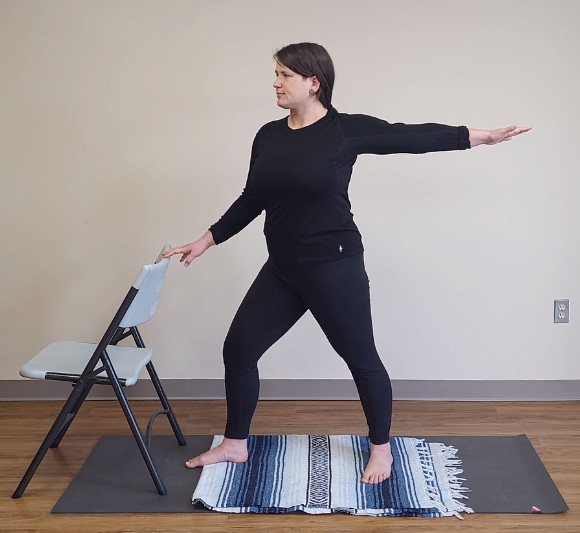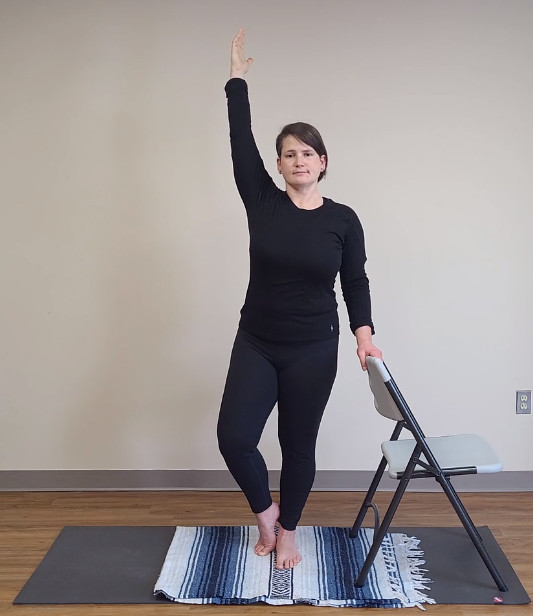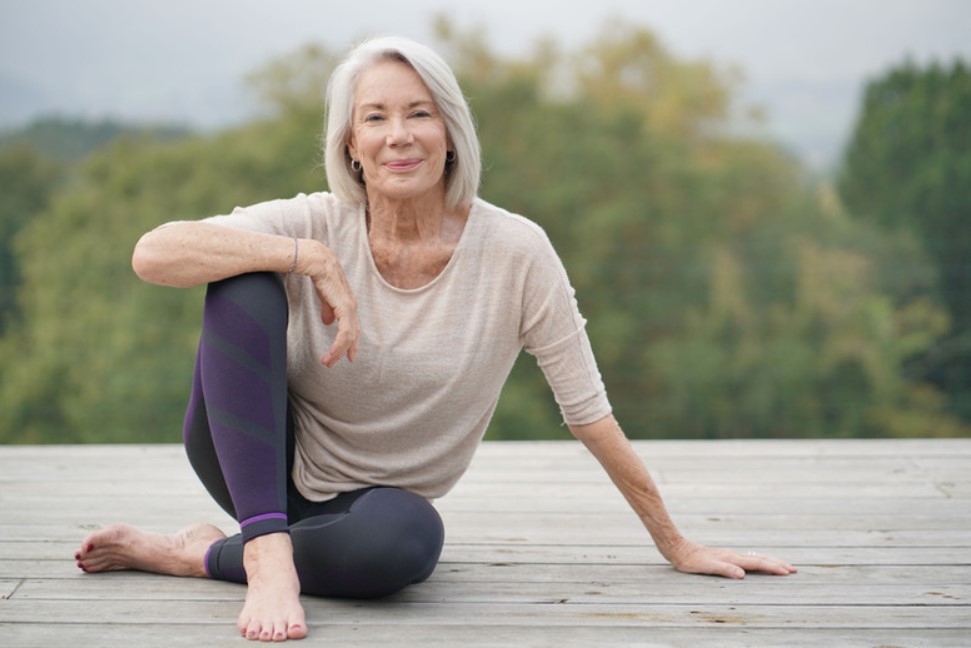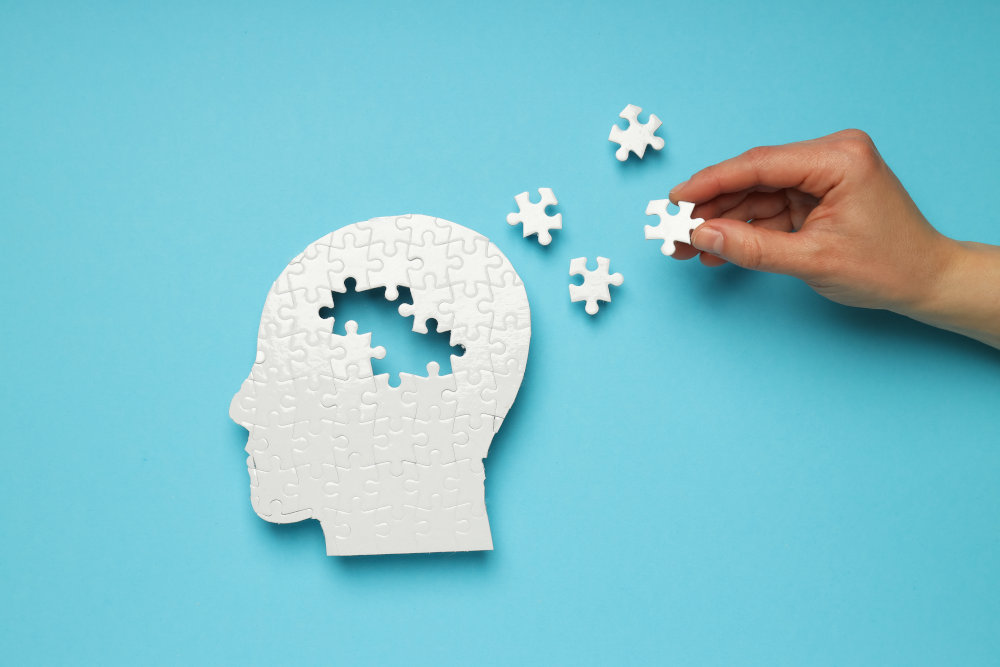By Christine Saari, MA, E-RYT, C-IAYT
If you find yourself grappling with suspicions of having osteoporosis, whether due to unexplained fractures, postural changes, or concerns about your bone health, the mix of emotions that accompanies such uncertainty—ranging from apprehension to a sense of vulnerability—can be overwhelming.
Osteoporosis is a condition characterized by low bone density and increased risk of fractures. Osteopenia is a precursor stage, with lower bone density than normal, but not as severe as osteoporosis. Both conditions are more common in women, particularly after menopause, but can also affect men.
The risks associated with osteoporosis and osteopenia include an increased likelihood of fractures, reduced quality of life, loss of mobility, and potential complications from fractures, such as chronic pain and disability.1
The emotional response to a diagnosis of osteoporosis varies widely. Individuals experience a range of emotions including shock, concern, sadness, fear, and vulnerability, as well as determination and motivation to manage the condition and improve their well-being.
If you have recently received a diagnosis of osteoporosis, you may initially struggle with the condition defining your identity. You may also worry about the potential stigma associated with it.
However, there is hope.
Yoga Therapy As A Resource For People With Osteoporosis Or Osteopenia
With time, many people develop resilience, adaptability, and a sense of empowerment to manage their condition. They are able to integrate it into their self-perception while seeking support and resources to navigate the challenges they may face.
In this article, we explore the research behind the use of yoga therapy applied to physical and emotional challenges associated with a diagnosis of osteopenia or osteoporosis. Discover four ways yoga therapists work with clients to support them during their treatment. Learn what it’s like to begin a yoga regimen with no prior experience, and incorporate these practices into your daily life.
Yoga Therapy: An Evidence-Based Approach for Treating Osteoporosis
Yoga therapists are trained to work with individuals with osteoporosis using evidence-based protocols that have been shown to slow or even reverse bone loss.2
While yoga has been practiced for centuries or more, and is widely known to provide health benefits,3 it is Western medical research that has produced the most compelling studies on the potential benefits of yoga therapy specifically for osteoporosis.
Dr. Loren Fishman is a prominent physician and researcher known for his work in integrative medicine. Much of his work focuses on yoga therapy and its potential benefits for various health conditions, including osteoporosis. Dr. Fishman conducted a randomized controlled trial (RCT) titled “Twelve-Minute Daily Yoga Regimen Reverses Osteoporotic Bone Loss,” published in the journal Topics in Geriatric Rehabilitation in 2016.4 This study focused on postmenopausal women with osteoporosis or osteopenia. Participants followed a 12-minute daily yoga routine for two years. The results indicated that the yoga practice led to significant improvements in bone mineral density at the spine and femur. This suggests a reversal of bone loss in these individuals.
However, many of the poses in the Fishman protocol are quite challenging for beginners, and may require significant modification for many individuals.
Yoga therapists work with people to tailor these exercises to the unique needs of each individual, making them accessible to beginners regardless of their health status or ability.
Four ways yoga therapists can facilitate your osteoporosis treatment
1. Learn to minimize your risk of fracture
Living with osteoporosis means taking extra care to protect your bones and reduce the risk of fractures. Everyday activities that may seem harmless can pose a potential danger.
Falls, lifting heavy objects improperly, engaging in high-impact activities without proper technique or bone strength, poor posture (especially excessive rounding or bending of the spine), and participating in activities with a high risk of falls or physical collisions, such as contact sports, golf, tennis, or extreme sports, can all contribute to an increased risk of fractures in people with osteoporosis.
Yoga therapists play a crucial role as educators in teaching people with osteoporosis how to keep themselves safe during their daily activities and in their yoga practice
Certain yoga poses commonly considered “gentle” may not be suitable for individuals with osteoporosis. Forward-bending poses that involve spinal flexion, like seated forward fold, can place excessive pressure on the vertebrae and increase the risk of fractures. Twisting poses, such as seated spinal twist, should also be approached with caution due to the potential stress they can put on the vertebrae.
Additionally, high-impact movements, including jumping or other vigorous twisting actions, should be avoided as they can strain the bones and increase the risk of injury. Yoga therapists can guide their clients towards low-impact alternatives that provide similar benefits without compromising bone health.
Not ready to give up your weekly golf or tennis lesson?
If avoiding certain high-risk activities is undesirable or unavoidable, a yoga therapist will work with you to learn how to minimize the risk as much as possible.
Balance poses can also be risky for individuals with osteoporosis. Having chairs or walls nearby can offer extra stability during balance poses, reducing the risk of falls and potential fractures.

By staying informed about the specific risks associated with certain activities, and increasing awareness of choice-making in daily activities accordingly, yoga therapists can support you in creating a safe and effective yoga practice to enhance your bone health and physical safety.
Regular communication and collaboration with healthcare professionals can also help tailor the practice to meet the specific needs of each individual.
2. Receive a customized yoga sequence to improve your bone density
Yoga therapists design personalized sequences based on the Fishman protocol, with the goal of slowing or even reversing bone loss in people with osteopenia or osteoporosis.
Your sequence will likely emphasize the importance of incorporating isometric contractions during static postures, holding them for a minimum of 30 seconds. During isometric contractions in static postures, individuals engage their muscles, or “hug muscle to bone” and hold a specific position without moving, such as maintaining a yoga pose like Warrior II or Tree pose.
Weight-bearing exercise is recommended as a key component of osteoporosis treatment and prevention, because long static holds of yoga postures have been shown to stimulate osteocytes, leading to increased bone density.5 By applying stress to the bones through yoga postures, osteocytes, specialized cells within the bone tissue, are stimulated and initiate a biochemical process that increases bone density. This occurs as the mechanical loading activates signaling pathways, leading to increased bone formation and decreased bone resorption.
A Different Approach To Conventional Exercise Programs
Before heading to your local gym once a day, consider this: unlike conventional exercise programs focused on increasing muscle mass, the exercises designed to stimulate bone stress should be performed in short bursts throughout the day. The focus is on increasing osteocyte activity, rather than building muscle mass and allowing time for muscle repair.
For example, a typical approach of lifting weights for muscle strength consists of multiple sets for an hour a few times a week. Instead, individuals aiming to enhance bone density should prioritize five to ten minutes of strong and sustained holds of at least 30-90 seconds per posture, repeated one to three times per day at home.
With consistent practice over time, yoga can help strengthen and densify the bones. This makes yoga an effective approach for managing osteoporosis.
The advantage of personalized yoga therapy sequences for osteoporosis is that they can be completed in under 15 minutes, making them targeted, time-efficient, and accessible.
3. Improve your balance and minimize your risk of falls
Yoga enhances balance and reduces the risk of falls through its positive impact on proprioception.6 Proprioception refers to the body’s ability to sense its position, movement, and spatial orientation. It involves the integration of sensory information from various sources, such as muscles, joints, and the inner ear, to maintain stability and control.
During yoga practice, individuals engage in a variety of poses that require focused attention, stability, and coordination. These poses challenge and improve proprioceptive awareness by activating the sensory receptors in the muscles and joints.
By regularly practicing balancing poses like Tree Pose or Warrior III holding onto a chair back, you can refine your proprioceptive skills. These allow you to develop a heightened sense of body position and control.

Through consistent practice, yoga promotes neuromuscular coordination and fine-tunes the body’s balance mechanisms. This leads to improved postural stability, increased muscle strength, and enhanced control of movement.
By cultivating a strong mind-body connection and refining proprioceptive abilities, yoga empowers you with the skills necessary to navigate daily activities with greater confidence and reduce the risk of falls.
4. Embrace your innate wellness
Yoga therapy offers you multifaceted support, helping address the stigma of an osteoporosis diagnosis. It can also help you embrace healthy lifestyle changes and improve your overall wellness.
Yoga encourages a strong mind-body connection, allowing you to develop a positive relationship with your body and embrace self-acceptance. By focusing on the present moment and practicing self-compassion, you can shift your perspective from a stigmatized diagnosis to a deeper appreciation for your body’s resilience and potential for growth.
Additionally, engaging in yoga can empower you to take an active role in your own well-being. The physical benefits not only support bone health, but also instill a sense of self-efficacy and empowerment, boosting your confidence and reducing the impact of stigma.
Yoga promotes a holistic approach to wellness, which extends beyond the physical practice. It supports you in your decisions around healthy lifestyle changes. These changes might include incorporating a balanced diet rich in nutrients essential for bone health, maintaining a regular exercise routine, and managing your stress levels. By embracing these lifestyle modifications, you can proactively manage your condition and take charge of your overall well-being.
And finally, yoga offers a unique opportunity for stress management through breathing exercises and meditation, which promote relaxation. Managing stress is crucial for individuals with osteoporosis, as excessive stress hormones can negatively affect bone health.
By incorporating these practices into your routine, you can enhance your overall wellness and better cope with the emotional aspects of your condition.
What It’s Like To Work With A Yoga Therapist If You Have Osteoporosis
Are you considering working with a yoga therapist, but feeling hesitant due to concerns about your stiffness or perceived lack of athleticism?
Rest assured, embarking on this journey can be a transformative experience, regardless of your physical abilities.
Each Individual Is Unique
When you step into a yoga therapy session, you’ll be pleasantly surprised by the inclusive and personalized nature of the practice. Yoga therapists understand that each individual is unique, with their own set of strengths and limitations. They will meet you exactly where you are on your wellness journey, tailoring the practice to suit your needs.
Gentle And Supportive Approach
It’s natural to worry about feeling too stiff or unathletic when starting yoga therapy. However, one of the most remarkable aspects of working with a yoga therapist is the gentle and supportive approach they take. They will guide you through modified poses and encourage you to listen to your body. There is no need to strive for perfection or compare yourself to others. Yoga therapy is all about cultivating self-awareness, self-care, and embracing your unique abilities.
Beyond Physical Postures
Yoga therapy goes beyond the physical postures. It emphasizes the mind-body connection and the power of mindfulness. Your yoga therapist will help you develop a deeper understanding of your body’s sensations. Additionally, they will teach you how to use your breath as a tool for relaxation and stability. Through this practice, you can let go of self-judgment and foster a compassionate attitude towards yourself.
Support
Your yoga therapist is there to support you every step of the way. They will take the time to listen to your concerns, answer your questions, and address any specific needs you may have. The sessions will be tailored to meet your individual goals and ensure your safety and enjoyment throughout the practice.
Working with a yoga therapist is an opportunity to embark on a new wellness journey. Regardless of your flexibility or athleticism, the practice will empower you to build strength, flexibility, and balance. It will foster a sense of inner calm and well-being that extends far beyond the physical aspects of yoga.
Remember, the yoga therapist is there to guide you every step of the way, ensuring that your practice is safe, enjoyable, and tailored to your individual needs. Embrace the journey with an open heart and an open mind.
Your wellness awaits!
Conclusion
Yoga therapy serves as a valuable resource for you if you have osteoporosis or osteopenia. The practices address both the physical and emotional aspects of your condition.
As we have explored in this article, the research supports the efficacy of yoga therapy in improving bone health, balance, and overall well-being.
Through the guidance of skilled yoga therapists, you can embark on a journey of self-discovery, embracing the mind-body connection and cultivating a positive relationship with your body. By incorporating yoga into your daily life, you can experience the transformative benefits of this practice. Learn how to navigate your osteoporosis or osteopenia with newfound strength, resilience, and a sense of empowerment.
So why not embark on your own yoga journey or refer a friend, and discover the transformative power of this ancient practice in supporting your bone health and overall wellness?
Yoga Therapy Associates provides yoga therapy at four locations in Connecticut, and via telehealth. Schedule a free consultation today.
References
- Kanis, J. A., Johnell, O., Oden, A., Sembo, I., Redlund-Johnell, I., Dawson, A., De Laet, C., & Jonsson, B. (2000). Long-term risk of osteoporotic fracture in Malmö. Osteoporosis international : a journal established as result of cooperation between the European Foundation for Osteoporosis and the National Osteoporosis Foundation of the USA, 11(8), 669–674. https://doi.org/10.1007/s001980070064
- Taylor, M. (2005). Osteoporosis: An Opportunity to Serve. International uournal of yoga therapy, 15(1), 97-104. https://doi.org/10.17761/ijyt.15.1.k447252t22u49704
- Ross, A., & Thomas, S. (2010). The health benefits of yoga and exercise: a review of comparison studies. Journal of alternative and complementary medicine (New York, N.Y.), 16(1), 3–12. https://doi.org/10.1089/acm.2009.0044
- Lu, Y. H., Rosner, B., Chang, G., & Fishman, L. M. (2016). Twelve-Minute Daily Yoga Regimen Reverses Osteoporotic Bone Loss. Topics in geriatric rehabilitation, 32(2), 81–87. https://doi.org/10.1097/TGR.0000000000000085
- Lu, Y. H., Rosner, B., Chang, G., & Fishman, L. M. (2016). Twelve-Minute Daily Yoga Regimen Reverses Osteoporotic Bone Loss. Topics in geriatric rehabilitation, 32(2), 81–87. https://doi.org/10.1097/TGR.0000000000000085
- Youkhana, S., Dean, C. M., Wolff, M., Sherrington, C., & Tiedemann, A. (2016). Yoga-based exercise improves balance and mobility in people aged 60 and over: a systematic review and meta-analysis. Age and ageing, 45(1), 21–29. https://doi.org/10.1093/ageing/afv175




